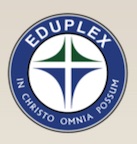Editor’s Note: In last week’s post, we introduced the Eduplex Training Institute (ETI) as an education training provider offering courses related to hearing and being available to individuals anywhere in the world through a unique global eLearning approach.
Hearing Aid Acoustician Programme Description
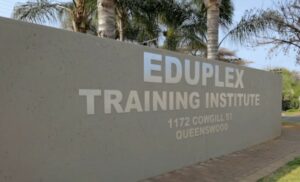 The Eduplex Training Institute recognizes that travel to existing, and often distant, educational sites is typically not practical or affordable. The training courses are designed for entry-level individuals, but provides them with quality education, rather than just “information,” to perform the intended work.
The Eduplex Training Institute recognizes that travel to existing, and often distant, educational sites is typically not practical or affordable. The training courses are designed for entry-level individuals, but provides them with quality education, rather than just “information,” to perform the intended work.
In this way, this program appears to be somewhat different, and therefore “disruptive,” from traditional professional training programs.
The ETI programs are aimed at teaching people who are committed to, and actively pursuing, a career in hearing aid acoustics and those involved in industrial hearing conservation, but who are not in positions to begin a four year, or even longer, educational program. , most of which is unrelated to their interest and work goal. In this way, the offerings are more consistent with a technical school than with a traditional college education.
Eduplex Training Institute (ETI) currently offers two programs:
- Inclusive Education for Hearing Impaired Children, and
- Hearing Aid Acoustician Programme
While currently offering these 2 courses, others are planned, involving pediatric audiology and hearing conservation. The online courses use self-directed learning, combined with Internet contact and practical sessions.
The Hearing Aid Acoustician Programme
The Programme consists of 8 modules, with each module including a different number of lessons.
- Module 1 – The Ear and Hearing
- Module 2 – Sound and Hearing
- Module 3 – Audiometric Tests
- Module 4 – Hearing Instrument Selection
- Module 5 – Earmoulds and coupling devices
- Module 6 – Hearing Instrument Fittings and Real Ear Measurements
- Module 7 – Technical Services and Repairs
- Module 8 – Patient Care and Administration
A Description of Module 1 and Module 2
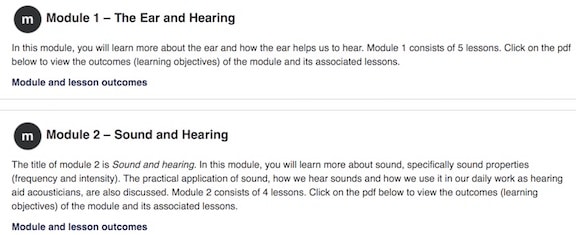
Module 1 and Lesson Outcomes
- Module 1: Ear and hearing
- After completion of this module, the student will understand and have knowledge of the anatomy and working of the ear, including binaural hearing, types of hearing losses and disorders of the ear
- Lesson 1: Hearing and hearing loss
- Explain and understand the difference between hearing and hearing loss.
- Explain the nature of hearing loss.
Module 1
Lesson 1: Hearing and hearing loss
1.1 Introduction
A hearing aid acoustician is a healthcare professional who specialises in the prevention, identification, diagnosis and treatment of people with a hearing loss who may specifically benefit from the use of a hearing instrument.
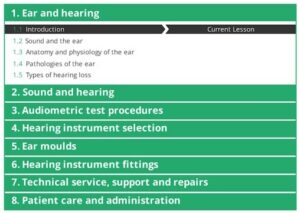
Figure 1. Modules for the Hearing Aid Acoustician Programme. Module 1, Ear and hearing, is expanded to show the lesson topics for this module.
Hearing aid acousticians work closely with other health-care professionals who help patients with a hearing loss. The Hearing Aid Acoustician Programme offered by the Eduplex Training Institute (ETI) consists of 8 modules (Figure 1). The first module is called Ear and hearing. Module 1 has 5 lessons.
As the student makes their way through the coursework, they can track their learning progress, through a displayed graph. The student cannot advance in any of the outline steps until the previous lesson has been completed. It is not even visible to them.
Online Site Features
- Site Navigation:
Login activity – last access to course, course blogs, forum discussions, how long on site.
Short videos (real life are also captioned), and animated teaching videos (proprietary art renderings). This allows the instructor also to monitor the student’s progress, dates and time of participation.
- Interactive eLearning and Quizzes:
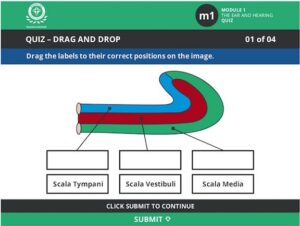
Figure 2. Example of one portion of an “in lesson” quiz. In this example, the student is required to drag the bottom term to the appropriate empty box at the top. This is one of four quiz questions related to the inner ear. The student cannot advance with any of the screens until the correct answer is confirmed.
An example of an interactive eLearning and/or quiz is shown in Figure 2. Once the student has clicked on the icon, the content is downloaded onto a second window. Once the quiz has been completed correctly (read through the interactive content), the student can close the window and continue with the lesson.
Assignments consist also of 10 multiple choice questions to be answered for each lesson. They are to be completed and submitted by a specified date. This is part of the monitoring progress for students. Final examinations are administrated by an independent company specializing in distance learning via video contact.
- Videos and Animations:
Videos and animations are part of the learning material (Figures 3 and 4). These must be viewed in their entirety for the student to advance in the lesson. All are custom designed for the site. Short videos (real life are captioned) and animated teaching videos are all proprietary art renderings.

Figure 3. Images of videos and animations used judiciously within the lessons to complement the text materials.

Figure 4. Images of videos and animations used judiciously within the lessons to complement the text materials.
- Additional reading (links):
Throughout the content, additional resources have been added. Prompts to these links are located at appropriate times in the lessons.
- More unique features:
- Examinations (not quizzes) are visually monitored by video using an independent agency.
- Visual interaction between students and instructors occurs so that the instructor can better determine the student’s involvement in the lesson. All students can be viewed at the same time.
- Student identification is confirmed via video, logs, and chats.
- No person has access to the site unless a registered student.
- The program is interactive.
- Progress through the course is systematic in that no advanced viewing of any section can occur until the previous step has been completed satisfactorily.
- The course has only an eBook, no hardbound materials.
Summary
This unique training program is seeking certification in order to provide the student who has completed the course(s) with accepted documents describing the skill level achieved.
Any suggestions from individuals on how this can be accomplished for this entry-level education should be sent to the Eduplex Training Institute directly.



